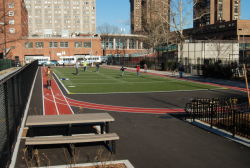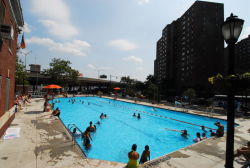Asser Levy Playground
Asser Levy Recreation Center, Pool and Playground
For outdoor pool details, including hours and rules, please visit our Free Outdoor Pools page.
The Asser Levy Recreation Center has its origins in the Public Health movement of the turn of the last century. Between 1820 and 1870, New York City’s population increased tenfold, while cholera and typhoid epidemics raged through crowded neighborhoods. Most tenement buildings lacked such basic facilities as toilets and showers. In 1896 a survey conducted in the Lower East Side revealed an average of one bathtub for every 79 families.
To fight dirt, and the ills associated with it, reformers promoted the idea of municipally-run public bathing facilities. The first plea for public bathhouses was made in an 1889 New York Times editorial by Dr. Simon Baruch, an authority on the "curative power of water," who had investigated the public baths in Europe. In 1895 a state law requiring local health boards to build public baths was passed. However it was not until 1901 that the city’s first public bathhouse opened at Rivington Street; this facility was named in honor of Dr. Baruch in 1917. He is perhaps better known as the father of Bernard Baruch, industrial and economic advisor to the federal government during both World Wars.
In 1903 the Department of Docks and Ferries surrendered property on Avenue A for a new bathhouse to the Manhattan Borough President. When it opened in 1908, the facility was called the East 23rd Street Bathhouse. It was designed by architects Arnold W. Brunner and William Martin Aiken. Echoing the style of ancient Roman baths, the architecture was inspired by the "City Beautiful" movement, a turn-of-the-century effort to create civic architecture in the United States that would rival the monuments of the great European capitals. In 1974 the bathhouse was honored as a New York City landmark. It is a superb example of the Roman Revival style, which features vaulted ceilings, balconies, mullion windows, skylights, and stone urns.
The bathhouse was later named for Asser Levy, a Jewish trailblazer in colonial times. The street to the west of the bathhouse was named for Levy by local law in 1954. Levy and a group of 23 Jews fled Brazil in 1654 to seek refuge in New Amsterdam. Shortly after their arrival, Governor Peter Stuyvesant attempted to evict the Jews from the settlement. Levy became the first Jewish citizen of the colony and was the leading advocate of civil rights for Jews, challenging Stuyvesant on such issues as citizenship, the right to bear arms, and property ownership. He was the first Jew to serve in a militia and own property, the first kosher butcher in the New World, and a founding member of Shearith Israel, the country’s first Jewish congregation. Shearith Israel’s synagogue (1897) on Central Park West was co-designed by Arnold W. Brunner, who was also the co-designer of the bathhouse at East 23rd Street.
In 1936 new outdoor swimming and diving pools and a new playground expanded the site’s recreational facilities. Parks gained jurisdiction over the bathhouse and recreation center in 1938. From 1988 to 1990, the facility was closed to the public due to an extensive restoration. Both indoor and outdoor pools were rebuilt, and a senior citizens’ room, auditorium, fitness center, and wading pool were added.
In 1993 the Asser Levy Playground opened, one of the first playgrounds in Manhattan built for disabled children. Funds were provided by the City, the Heckscher Foundation for Children, and the City Parks Foundation. The playground contains specially designed free-form game tables, wood and concrete benches, drinking fountains that are accessible to the physically challenged, and tactile paving for the visually impaired. The equipment, suitable for use by all children, features pull-up bars, balance boards, steps and ramps, chain ladders, and parallel bars.
Check out your park's Vital Signs
Clean & Safe
Green & Resilient
Empowered & Engaged Users
Share your feedback or learn more about how this park is part of a
Vital Park System










